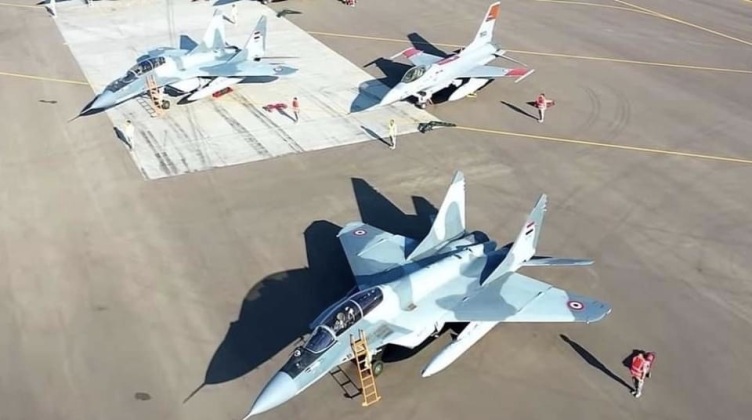News
Egypt Received Its First F-16s 40 Years Ago: The Beginning of the End For Major Power Status

In May 1982 the Egyptian Air Force acquired its first F-16 Fighting Falcon airframes, making it the first country in Africa to field fourth generation fighter aircraft and one of the first clients in the world for the American jets. The F-16 has formed the backbone of the country’s fleet over the past 40 years, today making up nine of Egypt’s sixteen squadrons today with 207 aircraft in service and accounting for almost all fighter acquisitions between 1982 and the change in government in the country in 2013. The only other clients to have acquired the F-16 in comparable numbers are Turkey, Israel and South Korea, although the Egyptian fleet has stood out from those of other clients for a number of reasons. While all other clients manufactured significant parts of the F-16 domestically, with Turkey and South Korea having full license production deals while Israel could extensively modify and improve the aircraft with U.S. support under the F-16I program, the Egyptian fleet by contrast saw few inputs from local industry. Rather than being enhanced, the aircraft were instead downgraded very significantly. Although numerous, Egypt’s F-16s today are considered among the very least capable in the world not only due to their downgraded avionics, but also their armaments suites with no standoff air to ground or anti ship weapons sold to the country. Air to air armaments are similarly poor, with only a limited number of AIM-7 missiles providing a beyond visual range capability – and these 1980s missiles being effectively entirely obsolete against modern air forces today.
The reasons for the very limited capabilities of Egypt’s F-16 fleet are manifold, with neighbouring Israel notably having initially opposed sales of the fighters to the country before considering it necessary to support Egypt’s transition from Soviet to American arms. While Egypt had received some of the USSR’s most capable fighters, and was set to be a leading client for the MiG-29 fighter and MiG-25 interceptor in the 1980s, F-16s could pose far less of a threat to the Israeli Air Force even if not downgraded – with the lightweight aircraft considered low end next to the heavyweight F-15s Israel was being supplied with. The fact that Egypt’s F-16s were far less capable than even Israel’s lower end fighters took significant pressure off Israel’s western flank and allowed the country to focus its military efforts from the 1980s on countering other adversaries such as Syria, Iraq and Iran. Had Egypt instead acquired MiG-29s, a fighter which was overall much more capable and would not have been arbitrarily downgraded, Israeli air superiority would have been far less certain.
Transitioning from Soviet to American arms also brought other restrictions which benefited Egypt’s potential adversaries, including strict American controls not only on how F-16s were equipped but also on which bases they could be deployed to within the country, with U.S. personnel having rights to inspect the aircraft and their facilities. No similar controls had been imposed by the Soviet Union. Before acquiring the F-16 Egypt also transferred its top Soviet supplied fighter the MiG-23 to the United States, which it had been the third to receive in the world after Syria and the Soviet Military itself, allowing NATO, Israel and their allies to study the design and thus prepare much more effectively for potential conflicts with Syria, Iraq, Algeria and other MiG-23 operators in the Arab world and beyond.

Egypt began to turn away from the F-16 in 2013 following the overthrow of the country’s Western aligned Islamist government that year, with the air force subsequently moving to acquire French Rafale and Russian MiG-29M fighters for its fleet. The Rafales would notably also be downgraded for Egyptian service, with Egypt being the only Rafale client not permitted to field modern Meteor air to air missile. This has left the MiG-29M as Egypt’s only modern fighter class with a non downgraded air to air capability, although Egyptian plans to follow the order for three squadrons with an acquisition of more capable Russian Su-35s were notably scuppered due to U.S. pressure. The much greater freedom of action which the MiG-29 provided Egypt was demonstrated by the fighters’ deployment to Sudan in 2020 for joint exercises – with such a deployment seen as contrary to Western interests and forbidden for Egypt’s F-16 units. Egypt’s decision to acquire the MiG-29, alongside S-300 and BuK air defence systems and other Russian aerial warfare assets, is thought to have been motivated both by Washington’s decision to freeze spare parts supplies to the country in 2013, as well as by the NATO unexpected assault on neighbouring Libya in 2011. The latter incident raised concerns that Egypt’s own airspace would be similarly if not even more vulnerable than Libya’s had been.
The future of Egypt’s F-16 fleet today remains highly uncertain, as does the future of the country’s foreign relations, with Western pressure to avoid Russian and Chinese weapons systems potentially leading Cairo to invest more in the F-16 fleet. A further pivot away from the West, by contrast, could lead to the Falcons’ early retirement and to more acquisitions of MiG-29s and other non Western aircraft which are not comparably downgraded. Egypt’s F-16s are comfortably outmatched by the top fighters of all of its neighbours, and considered insufficient for roles beyond counterinsurgency, meaning the future of its fleet will also largely be determined by Cairo’s perceptions of the likelihood of war with other state actors. A greater possibility for such conflict is expected to result in more acquisitions of non Western aircraft like the MiG-29M.












